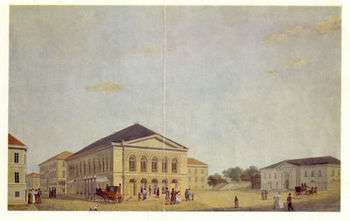Christiania Theatre
| Christiania Danish Theatre | |
 Christiania Theatre in the 19th century, gouache by architect Christian H. Grosch. | |
| Address |
Christiania Norway |
|---|---|
| Opened | 4 October 1836 |
| Closed | 1 September 1899 |
Christiania Theatre, or Kristiania Theatre, was Norway's finest stage for the spoken drama from October 4, 1836 (opening date) to September 1, 1899. It was located at Bankplassen by the Akershus Fortress in central Christiania, in Norway. It was the first lasting public theatre in Norway and the national stage of Norway and of Oslo during the 19th century.[1]
History
Christiania Theatre was the first long term public theatre in Oslo. In November 1771 and February 1772, Martin Nürenbach made an unsuccessful attempt to start the first public theatre in Oslo. Aside from this, theatre was performed only by the private amateur society Det Dramatiske Selskap at the concert hall Gevaexthuset, who did not offer public performances, and by travelling foreing theatre companies.
The first public theatre, the Christiania Offentlige Theater was inaugurated by the Swedish theatre director Johan Peter Strömberg in January 1827. This was to be the predecessor and origin of the Christiania Theatre. After the building burnt down on 5 November 1835, it was reinstated with the name Christiania Theatre in October 1837.
Over next few years an avid debate developed with strong criticism of the Danish dominancy of the arts. Christiania Theatre only employed Danish actors during its first history for which it was criticized. The reason given was that there was not an acting school in Norway and that the Norwegian actors were therefore not good enough. The Norwegian language conflict often centering on Norwegian writers who gradually adopted distinctly Norwegian vocabulary in their work. Henrik Wergeland may have been the first to do so. Art critic Johan Sebastian Welhaven was one of the conservatives who took out against the theories of the extreme nationalists. The Danish troupe was eventually mixed up with Norwegian actors after the employment of Norwegian actress and prima donna Laura Gundersen in 1849.
The foundation of the first Norwegian theatre in Oslo, Christiania Norwegian Theatre in 1852, was but a temporary rival, as it was forced to close down in 1862. The theatre was a result of the controversy surrounding the Norwegian and Danish languages and was created as a counterpoint to the Danish language dominated Christiania Theatre. Henrik Ibsen was artistic director of the Christiania Norwegian Theatre from the autumn of 1857 and served as the theatre leading director until its bankruptcy in 1862.[1]
From 1856, the Christiania Theatre promised to employ native actors. In 1872, Norwegian became the stage language. Ibsen's famous play Peer Gynt premiered here in 1876, as well as a large number of important Norwegian productions, including productions of Norway's other national bard at the time, Bjørnstjerne Bjørnson. During the continued run of Peer Gynt a fire started on the performing night of January 15, 1877 that heavily damaged the theatre, but luckily the theatre could later be repaired. Christiania Theatre was during its years in use seen as Norway's national stage for drama until the Nationaltheatret was opened on 1 September 1899, with Bjorn Bjornson as theatre director and a large part of the ensemble from the Christiania Theatre.
References
- 1 2 Store norske leksikon. "Christiania Theatre" (in Norwegian). SNL.no. Retrieved 23 August 2011.
Sourcres
- Blanc, Tharald Christiania Theater's Historie, 1827-1877 (Oslo: Cappelen. 1899) ISBN 978-1-168-23052-2
- Lyche, Lise Norges teaterhistorie (Oslo: Tell forlag. 1991) ISBN 82-7522-006-8
- Næss, Trine Christiania Theater forteller sin historie: 1877-1899 (Oslo: Novus forlag. 2005) ISBN 82-7099-427-8
- Schmiesing, Ann Norway's Christiania Theatre, 1827-1867: From Danish Showhouse to National Stage (Fairleigh Dickinson University Press. 2006) ISBN 978-0-8386-4107-1
External links
- The New City Theatre in Oslo (in Norwegian)
- Nasjonalbiblioteket (in Norwegian)
Coordinates: 59°54′32″N 10°44′29″E / 59.90889°N 10.74139°E